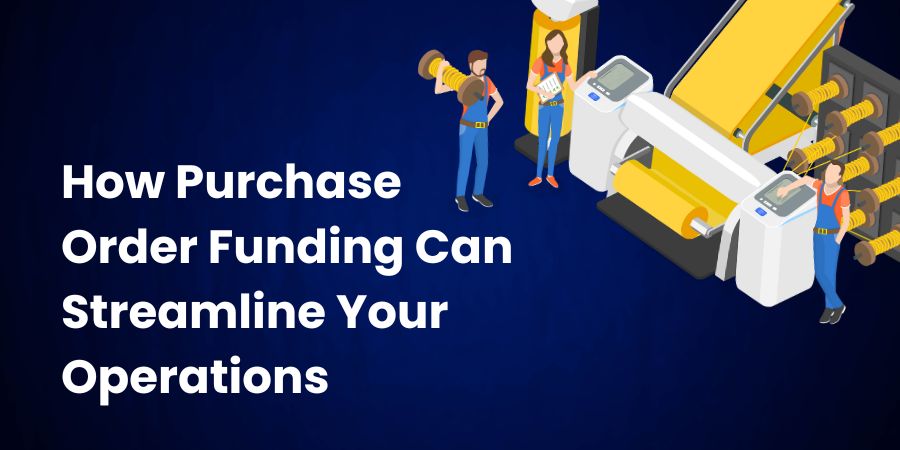In today’s competitive business landscape, streamlining operations is crucial for success. One aspect that often poses challenges for businesses is managing the inventory-to-delivery process efficiently. However, with the advent of purchase order funding, companies now have a powerful tool to streamline their operations and optimize their supply chains. In this article, we will explore how purchase order funding facilitates a smooth journey from inventory to delivery, benefiting businesses of all sizes.
Accelerating Operations: How Purchase Order Funding Streamlines Inventory-to-Delivery Processes
Optimizing Inventory Management
One of the key ways purchase order funding streamlines operations is by optimizing inventory management. With this financing solution, businesses can maintain adequate inventory levels by accessing funds specifically for purchasing raw materials or finished goods. By having the necessary capital on hand, they can ensure timely restocking, avoiding stockouts or overstocking. This improved inventory management helps businesses meet customer demands more effectively and enhances their overall operational efficiency.
Accelerating Supplier Payments
Another significant aspect of streamlining operations is ensuring prompt supplier payments. Purchase order funding enables businesses to pay suppliers promptly, as they can use the funds obtained to settle invoices quickly. By accelerating supplier payments, companies can build and maintain strong relationships with their suppliers. This can lead to various benefits, such as favourable negotiation terms, discounts, or access to priority supply channels. Such advantages can significantly enhance a company’s ability to deliver products on time and maintain a competitive edge in the market.
Enhancing Production and Fulfillment
Purchase order funding also plays a pivotal role in enhancing production and fulfillment processes. When businesses receive large orders or experience increased demand, they often need additional resources to fulfill those commitments. With purchase order financing, companies can access the necessary funds to meet the increased demand, whether by ramping up production or sourcing additional inventory. By leveraging this financing solution, businesses can seize new opportunities, take on larger orders, and expand their client base. This leads to improved customer satisfaction and positions the company for greater market competitiveness.
Minimizing Cash Flow Gaps
Cash flow gaps can hinder businesses during the inventory-to-delivery process, impacting their ability to fulfil orders and make timely payments. Purchase order funding addresses this challenge by minimizing cash flow gaps. With quick access to funds, businesses can cover production costs, pay suppliers, and bridge any financial gaps that may arise during the fulfilment process. This financial stability ensures smooth operations and enables businesses to seize growth opportunities without being constrained by cash flow limitations.
Conclusion
Streamlining operations from inventory to delivery is essential for businesses seeking sustainable growth and success. Purchase order funding offers a valuable solution that optimizes inventory management, accelerates supplier payments, enhances production and fulfilment, and minimizes cash flow gaps. By leveraging this financing tool, businesses can improve operational efficiency, meet customer demands, strengthen supplier relationships, and drive overall growth. As companies navigate the complexities of supply chains, purchase order funding serves as a strategic asset, empowering them to streamline operations and achieve their goals in today’s competitive marketplace.
Frequently Asked Questions
Q: What is Purchase Order Funding?
Purchase Order Funding is a financial tool used by businesses to finance the purchase or manufacturing of goods that have already been sold via purchase orders from customers. It provides the capital needed to fulfill orders when a company lacks sufficient funds, ensuring that sales do not fall through due to cash flow issues.
Q: How does Purchase Order Funding work?
When a business receives a large order from a customer but doesn’t have enough capital to fulfill it, a PO funding company pays the supplier directly for the cost of producing and delivering the goods. Once the goods are delivered, and the customer pays, the transaction is settled: the funding company takes its fees, and the remainder goes to the business.
Q: Who can benefit from PO Funding?
Businesses in industries such as manufacturing, distribution, wholesale, and retail, especially those experiencing rapid growth or seasonal fluctuations, can benefit from PO funding. It’s particularly useful for startups and SMEs that may not have large amounts of capital or extensive credit histories.
Q: What are the main benefits of using PO Loans?
- Improved Cash Flow: It provides immediate working capital to fulfill orders.
- Growth Enablement: Allows businesses to accept larger orders than their current cash reserves can support.
- Supplier Assurance: Suppliers get paid upfront, which can negotiate better terms.
- No Equity Dilution: Unlike raising equity financing, PO funding does not dilute the business owner’s equity.
Q: Are there any drawbacks to PO Funding?
The main drawbacks include the cost, as fees for PO funding can be higher than traditional financing options. It’s also important to note that not all orders or industries may qualify for PO funding, depending on the funding company’s criteria.
Q: What types of goods qualify for PO Funding?
Most PO funding companies focus on tangible goods, particularly those that are easily resold in the event of a default. Custom-made items with limited resale value, or goods that are heavily regulated, may be less likely to qualify.
Q: How quickly can I access funds through PO Funding?
The speed of funding can vary but is generally faster than securing a traditional loan. Once the funding company verifies the purchase order and conducts due diligence, funds can typically be accessed within a few days to a week.
Q: What documentation is required to apply for PO Funding?
Required documentation usually includes the purchase order from the customer, details about the supplier, and the company’s financial statements. Some PO funders may also require information about the company’s history and the creditworthiness of the customer.
Q: How is PO Funding repaid?
Repayment happens once the end customer pays for the delivered goods, typically through a process where the payment is made directly to the funding company, which then deducts its fees and remits the balance to the supplier.

